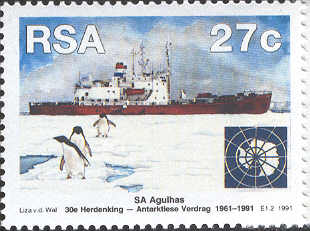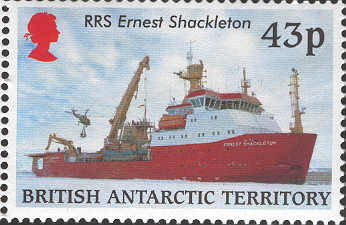
AGULHAS, built in
1977 by Mitsubishi, is an oceanographic and support ship of 6122
tons.
40 crew and 98 scientifics board for "cruises" at 14 knots maximum.
|
Ships in Antarctic (2) |
| Some ships use to go to Austral lands from South Africa. The country is is among those which have signed the treaty of Antarctic and in 1959 takes possession of the Norwegian base at Queen Maud Land. Marion Island (46°52'S, 37°51'E), discovered by Marion-Dufresne and Gough Island, off Tristan da Cunha are also part of South-African polar lands. | |
|
|
AGULHAS, built in
1977 by Mitsubishi, is an oceanographic and support ship of 6122
tons. |
| In 1948 the Antarctic Division (AAD) is established to administrate ANARE (Australian National Antarctic Research Expeditions) which in 1997 celebrate their 50th birthday. Australian Antarctic Expeditions embrace the activities in Antarctica of both government and non-government bodies and individuals, with a central focus on scientific research. From Hobart, ships chartered by the AAD are sent to antarctic and subantarctic stations each year carrying passengers and supplies for year-round activities. | |
|
KISTA DAN is the first of Danish ships, built for Lauritzen Lines.
From 1954 to 1957, she is chartered by Australia to relieve the base at Macquarie Island.
She takes part to missions to establish Mawson base, in 1954, then in
January 1957 to Davis base. In 1959/60 and 1960/61, KISTA DAN served the Falkland Islands Dependencies Survey (FIDS)
to supply Deception Island and South Georgia, then the British
Antarctic Survey (BAS) from 1961 to 1966. Renamed BENJAMIN BOWRING, she is chartered by South Africa in 1979. |
|
|
|
|
| NELLA DAN is launched in 1961: she is a single propeller cargo ship of 2206 tons, with an ice-stengthened hull of heavy steel. She used to visit Antarctic three times a year, from 1961 to 1982: she supplied the bases Casey, Davis et Mawson and the Station on Macquarie Island where she was badly damaged in December 1987. |
|
 |
Australia's ice research ship AURORA
AUSTRALIS is a platform for a growing program of research in the
Southern Ocean to the South and Southwest of Australia. Launched on the 18 September 1989, the ship was built by P&O Polar. Designed by Wartsila Marine Industries of Finland, the Aurora Australis, 3500 tons, is capable of penetrating 1.2 metre thick ice at 2 knots. She can carry 1600 cubic metres of general cargo plus 40 containers, and can accommodate 133 people including the crew. |
|
The United Kingdom made the first territorial claim to part of Antarctica in 1908, by Letters Patent. It has maintained a permanent presence in the British Antarctic Territory since 1943, when Operation Tabarin was established to provide reconnaissance and meteorological information in the South Atlantic Ocean. This ‘secret’ wartime project, which became the civilian Falkland Islands Dependencies Survey in 1945, became in 1962 the British Antarctic Survey (BAS). The BAS is responsible for most of Britain’s scientific research in Antarctica.Originally administered as a Dependency of the Falkland Islands, the BAT became an Overseas Territory of the United Kingdom on 3 March 1962. |
|
|
|
Sister-ship of KISTA DAN, PERLA DAN, launched in 1958, 2353
tons and 12,5
knots, was used by the
British Antactic Survey to take material to Halley Bay for the
construction of a new base from 1967 to 1970.
|
| ANITA DAN is launched in 1956 to serve in Greenlandic
waters. In 1967, ishe was bought by the MoD and after some transformations,
becomes the A171 HMS ENDURANCE, patrol and supply ship. She carries two Whilrwind helicopters replaced by two Lynx. She will be mobilised during the Falkland war. In 84, back from an expedition from Brabant Island, she must be towed by RRS BRANSFIELD after grounding a submerged rock. She is decommissioned in 1991 after 22 missions in Antarctic. |
|
|
|
The ice-stengthened cargo ship RRS BRANSFIELD steams for her her maiden trip in 1970. She is the main supply ship of BAS until 1999, completed by RRS John Biscoe. She was equipped with a helicopter plate-form and limited research facilities. Her two diesel electric engines gives her a speed of 13 knots lduring her 234 annual days at sea. |
| Two ice-stengthened Royal Research ship (RRS) Ernest SHACKLETON and RRS James Clark ROSS support the Antarctic Operations for the United Kingdom. | |
 |
|
RRS Ernest SHACKLETON was acquired in 1999 to Rieber Shipping, in Norway. The former Polar Queen is an icebreaker of 80 m long powered by two diesels of 2550 kW. |
Built in 1991, RRS James Clark ROSS provides 650 sq m to Scientifics. Long of 99 meters,she can reach the maximum speed of 15.7 knots thanks to 4 Diesel engines of a cumulated power of 3200 kW. |
|
See also the page dedicated to two other ships named ENDURANCE |
|
Click below for the pages list |
|
|
Page on line on 11-06-2004 Update on: |